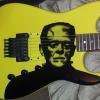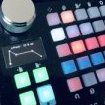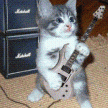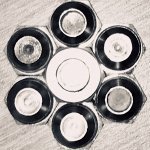Leaderboard
Popular Content
Showing content with the highest reputation on 01/14/2022 in all areas
-
An interesting thought occurred to me the other day. I do a lot of recording work using sample libraries. One of the big differentiators in the quality of sample libraries tends to be the ability to apply various manual articulations to the notes. It really doesn't matter what type of instrument be it strings, horns, flute, pedal steel, bluegrass fiddle, harmonica, etc. They all provide various methods for controlling attack, vibrato, swell and so forth usually quite different for different instruments. It's fairly uncommon in modeling forums to hear much discussion about various articulation methods unique to the guitar, which leads me to question whether or not the Helix can sometimes become an impediment to newer guitar players developing these types of skills on the guitar such as palm muting, hybrid picking, neck versus bridge attack, pick technique and so fort. In other words there's so much emphasis and interest in the use of different amps or effects, there's not much left for learning how to enhance the mix of their guitar with the rest of the band or the tracks of a recording through the use of various articulation techniques. What's your take on this?4 points
-
When I first started to mess around with guitars in the mid to late 1960s it was with an old beat up Eastern European Tatra jumbo acoustic from a pawn shop. There was nothing particularly good about it, but I managed to level the frets and get the action a little better and start off with an attempt at finger picking folk tunes (I was an art student at the time so this was normal). I later got a Japanese copy of a Les Paul and an very old Selmer 50w amp. The only thing between the amp and guitar was a cable! Nothing else. Let's face it, thats the way the old blues men started and that 's how it was back then. I started to learn how those guys managed to get their sound - change the tuning and use a pocket knife or the neck of a beer bottle as a slide. It must have been a couple of years, or more, before i got my first wah pedal and fuzz box. Don't get me wrong, I love this technology and buying a kidney bean POD, when they first arrived, was a revelation - how could all that be in one tiny box? Then I moved to the POD XT Live, then the HD500 and now, of course, the Helix. Nowadays, I have a bunch of different guitars - electric, acoustic, nylon, resonator, a couple of Variax, plus mandolin, banjo, autoharp and a whole heap of synthesisers and FX. I suppose being an older person gave me the grounding in basics, mainly because there was no alternative. The Beatles started out with essentially no effects, Rickenbacker guitars and Vox amps, Clapton had the Les Paul and a Marshall. It was a whole different world back then, effects were "special" and applied in the studio by a trained engineer. Stuff you could simply plug your guitar into were very rare, and there was a rumour that Jimmy Page and Jeff Beck shared the first Tone Bender fuzz box . I remember my best friend buying an amp with a built in reverb, then added a tape echo - it was astonishing. Ye gods, can you imagine what Jimi Hendrix would have made of the Helix? He might have gone down the rabbit hole too. Maybe I'm just getting too old, but some of the requests for the more esoteric boutique amps are beyond me, there are only so many variations of amp design. The basic amp is still using tech from the middle of the last century, similarly so are most guitars which have ultimately been derived from Lester's "log".3 points
-
Major impediments to learning guitar with emphasis on articulation: 1 - Failure to take lessons from a live human (vs internet), preferably one who performs in a genre where articulation is all. 2 - Failure to start on an acoustic guitar. Focus goes to the electric aspect vs manual skills. 3 - Compressors and high gain amps. 4 - FX in general. 5 - GAS, FOMO, peer pressure. I started playing at 10yo (I should be a LOT better than I am!). Starting on a gigantic Harmony arch-top f-hole acoustic, I took lessons at an old-time neighborhood music store that employed teachers who performed in multiple genres (mostly jazz & classical). Among other skills, my teacher insisted that I learn proper hand placement, alternate picking, muting with ALL parts of BOTH hands (not just palm muting), playing scales and exercises using all 4 left hand fingers AND, when necessary, thumb over. I didn't know I was learning CAGED, but cowboy chords were immediately followed by "orchestral" (bar) chords. He also taught me how to get different sounds by picking at different places on the string, and introduced me to the concept of string bending. This was 1960, so r'n'r was still considered "Devil Noises", but my teacher was a musical liberal. After Mel Bay Book 1 he showed me the "Guitar Boogie Shuffle" (I-IV-V) and "Rebel Rouser" (Duane Eddy - employed string bending). Before we got to proper finger picking I joined a band, playing Bass. I found a Bass teacher (music schools didn't have ELECTRIC Bass yet), who INSISTED that I NOT use a pick! The only PROPER way to play Bass is with fingers! UNLESS - you're after that "special" percussive effect. Another musical liberal. Nowadays "whatever works" is the rule, and galloping HM basslines are much easier with a pick. My point is, while there are certainly great self-taught guitarists, for most kids, a proper teacher is essential. the trick is finding one who doesn't kill the joy of music. It also helps if your parents can't afford (or refuse) to buy you all that "electric crap". If you really want it, you'll get a job and develop a work ethic, but that's a rant for another day!2 points
-
Philippe Abed, Please leave your user ID and password. We will destroy your account for you. Thank you. Nigerian Prince2 points
-
I would not necessarily call it an "impediment", but IMO one thing's for sure: Plenty of people drool about amps/models and what not a lot more than they care about their playing. Without even willing to point my finger at anyone specifically, I have often read people going all mad about how killer this or that new piece of gear (or even just a software update) would sound - and then, in case some sound examples coming from the same persons are available, I'm pretty often like "uhm, you should rather concentrate on muting strings rather than praising the new, super-duper accurate piece of kit you just got your hands on". Just so that nobody gets me wrong: I don't have any problems with most people not being kickass players. I also don't have any problems with them loving their gear. But all that endless GAS along with plenty of time spent on all kinds of chatter about how much an authentic amp such as XYZ would improve the general situation sooo much could IMO quite often be spent a lot wiser by investing some time into what's still the core thing of all this, namely guitar playing. Personally, while I defenitely love some new toys as well (especially in case they're inspiring in one way or the other), I have always been more the player kinda guy (no, that's not supposed to say anything about the quality of my playing), so regardless of whatever new toys, I rarely really "needed" them, unless it's for "ultility improvements" - which is also why I'm rather asking for global blocks than for new amp models. Typically, I just need some "working" sounds and then I usually just forget about those things. Apart from some things my "inner experimental me" would like to see (such as modulators, synth-style effects and what not), the Helix is already providing anything I need for my core needs in spades. There's decent clean, mid-gain and higher-gain sounds, case closed. Fwiw, I have spent a very looong time in the IR rabbit hole, but even that was kinda purposedly, because I wanted some cab simulations to make my live experience more pleasant. Once I had what I needed, I almost stopped fooling around with these things any longer. I do still spend some time on that stuff every now and then, but nowadays it's more like "ok, let's take this one amp model, see whether I like it and then brew a perfectly suitable custom IR". Sometimes that's working quite well, but usually I get bored quickly, return to the handful of "safe" sounds I already have and rather focus on playing. Having said all that, most of my "working" colleagues do it pretty much the same way. Get a decent axe, decent amplification, the modification/switching options required to play live and call it a day for a long time. And well, yeah, sure, that can become an impediment for less experienced players - very often they seem to think searching for new sounds would improve things in whatever way, rather than concentrating on all things playing related.2 points
-
For sure modeling does waste much more of your time, fiddling around all those possibilities and sounds. It's an endless tone chase and sometimes it can be a damn rabbit hole. I think this applies to the entire pedal market nowadays. Sometimes it's a just lot of showoff, sometimes just an infinite pedal flipping, and for these reasons it can be an humongous waste of time. Im old school and even if I use modeling since the red bean pod era, I learned guitar in the early 80, with just an amp and a damn guitar. Nothing in the middle. Sometimes just a pedal or two. It's granted that if you start learning this way, you focus a lot more on qualities you mentioned for two basic reasons; there is nothing else to mess around with, and the less the pedals and effects, the more your touch and style are exposed. Well, stating the obvious here, it also depends what kind of genre you are playing, because if you are just a 250BMP metal shredder, there is no much articulation to talk about. On the other hand, if you are into jazz or blues, where the base tone it's extremely easy to find even with the cheapest amp and guitar in the market, it's better you focus on those aspects you mentioned, or you'll be stuck as a mediocre player, doesn't matter if you have a Fractal or a Zoom, a chinese Casino or a 20K Gibson L-5... My take on this is that a kid learning guitar should not have access to all these toys, until he develops his own style with just basic tools. Then, if there is zero talent available, doesn't matter what you get, articulation (as the expression of dynamics through your playing technique) will always be felt as artificial. Which is more or less what I perceive when I listen all those famous youtube players, doing pedal reviews, 24/7. I guess that's also why I'm totally fine with Helix, and my other pedals. I just use them as "extras" to my style like if they were extensions of my palette, instead of trying to create (or hide) my style through those devices.2 points
-
Yes, the toe switch is not required. It can be set to activate after a determined amount of travel in the pedal. I'm not sure about that particular pedal with with the HX FX. I use my expression pedal with an LT. Mine is an old Crybaby I've modded, there's a thread about it here: I did stuff a spring in the toe to make it spring loaded. So it's working exactly in the fashion that you are inquiring about. It performs great and is very solid. Been using it for years now.1 point
-
When Helix controls Variax models, tone, volume, string volume, tunings, etc, it is making changes in the Variax itself, not in Helix. Helix is just storing the commands to send to Variax when the patch is selected. So if you had two inputs on two different paths that both use Variax, each of them will be sending commands to the same guitar, so the last one sent would win.1 point
-
If you create an "aggregate" device which incorporates both ASIO drivers, you should be able to take the input from Helix and route the output to the Scarlett. There are drawbacks which I can't address because I'm a PC guy, maybe some of the MAC folks will address that. My question would be "WHY?". The 8i6 (IIRC) has SPDIF. If you take the signal from the Helix SPDIF it eliminates that AD/DA conversion. If it's solely to use the Helix ability to output a DI (unprocessed) track for re-amping, you can incorporate a SEND Block at the beginning of the FX chain and wire that to the Scarlett analog inputs. What do you hope to accomplish?1 point
-
Food for thought: Pick any of the common famous guitar players. How many different core tones are they using? How many different effects? How many different guitars? I'm sure you'll find that most of them a) developed their own voice on a rather limited amount of gear, b) would still sound like them through pretty much completely different gear. Yes, there's exceptions, let's say such as Gilmour, Fripp, Belew and whom else - but even if you take away the FX stuff they're making much use of, pretty much all of them would still sound like themselves. Take, say, Paul Gilbert. He's a living guitar music encycopledia with a built-in juke box. And he manages to perform, say, some Beatles stuff or even some Gypsy Jazz pretty much authentically using his usual core tone, namely a rather overdriven Marshall kinda amp. Same goes for Phil X. My own experience from playing in cover bands for decades would sort of back this up. With all the projects, we usually don't do 1:1 (Top 40 style) covers but some versions leaving us some room for our own playing. Note: These are very well paid jobs, so the folks hiring us could afford pretty much any other band. But they don't care for an authentic representation of whatever but seem to vastly prefer decent musicians having fun with their own interpretations (and yes, there's also plenty of the typical wedding/birthday jobs that you'd usually see a Top 40 band playing at). Get the core idea of the music right, get decent musicians to perform with fun and ideally some great singer(s) and that's all you need. And along these lines, in any of these projects, nobody would ever care whether I play the "Le Freak" guitar pattern (which is one of the few key elements that likely need to stay, even when doing jam-alike interpretations) with a Strat through a Twin or with a Les Paul through a hairy Marshall. Well, maybe some guitar players would get out their cork sniffing cutlery - but rest assured, I couldn't care less. Fwiw, having talked about Phil X, there's him doing a cover of Stevie Wonders "Superstition" - and IMO it's every bit as great as any of the Top 40 band versions trying to mimic things 1:1. If you want the real deal, put on Mr. Wonders record or attempt a show. For anything else, enjoy what good musicians can make out of it. Here's a pretty tamed version of Phil X: And a pretty raw live jamming version with Guthrie Govan as a guest: I vastly prefer that kind of approach over literal covers. And most audiences seem to, too. The good thing being that you can completely forget about delivering "authentic" tones.1 point
-
1 point
-
Very interesting topic. I started lessons with classical, nylon-string guitar because I saw Segovia in concert as a child, and thought he was cool :) Starting my guitar-playing years with my fingers is why to this day I use a thumbpick instead of a flat pick. This allows for articulations that are difficult/impossible for me to do with a flat pick. Ultimately whether Helix will complement or obscure a person's articulations depends a lot on how well they know the gear. It's amazing how people who tell me that "amp sims suck" change their mind when I tell them to try cutting whatever gain or drive setting they're using in half. Physical amps soak up transients, and interact with the guitar in a way that an audio interface's high-Z input doesn't. Someone in the thread about my book mentioned that the section on how to get clean sound from "dirty" amps was, to him, one of the best parts of the book. I don't think he had previously tried turning down the gain enough to really let the articulations come through. As to options and rabbit holes, perhaps the reason for having so many options is so people can settle on their own "greatest hits." I'm sure some of my favorite Helix amp models are other people's least favorites. There's a limited number of specific Helix amps and effects that are the basis of "my sound." I'm quite sure if you talked to 100 different Helix owners, you'd have 100 different lists of their favorites amps and effects. My preferences is to use a minimum number of effects and exploit each one to the max, but other people like a guitar sound that's almost more like a keyboard synthesizer, and layer lots of effects to achieve that goal.1 point
-
Wow, thank you for the comprehensive response voxman55, I'll be experimenting over next few days and I'll let you know how I get on. I agree that her live sound does sound good. I'm mainly going direct into Jamulus and monitoring using headphones - but get your point about using FX return when using an amp. Many thanks,1 point
-
Great... I'll also check those videos. Thanks a lot.1 point
-
I'm glad to hear I'm not the only one noticing this. I was particularly interested in some of the things PierM was saying about being more "old school|" in his approach which I think applies to many of us that started playing before the glut of pedals and tools came out and diverted people's attention. And Sascha Frank's experience most closely resembles mine as far as finding the basic setups I need and not veering far from it. I do think there are some other factors that feed into this, one of which is the makeup of bands nowadays. It's relatively rare to see bands with LOTS of different instruments simply because of the pay scale used for paying most bands simply doesn't allow it. One of the things that began bringing this aspect of technique more to my attention was that addition of using "session instrument tracks" with my band. These aren't exactly backing tracks but rather individual instrument tracks which play along with the band on different songs. Once I began using these I noticed how much I need to change my approach to my playing in many if not most of the songs simply because there wasn't room for me to fill as much and I would be competing with the other instruments if I overplayed, so it more or less forced me to fall back to the techniques I used back when bands consisted of more than three or four instruments in order to blend and fill within that context. I think there are a lot of players that started playing in this newer age of limited band size and probably depend on many of these effects and such to help fill the space in an otherwise sparse instrument environment. It makes me think of one of the internet groups I tend to pay a lot of attention to which is Scary Pockets. It's not a whole lot of instruments, but each instrument contributes only what's necessary for the song to sound complete and professional..but all done live in someone's living room, for example. In their case it's all technique and very little in the way of effects and flashy stuff. Interesting approach to say the least.1 point
-
True story: Microsoft put together a focus group on Word to come up with 20 (IIRC) most-requested features, so they could be included in the next version. It turned out Word already had them, but the users didn't realize they were in the program. (Maybe the focus group should have concentrated on how to improve the documentation...) Helix still has a lot of tricks up its sleeve. The Poly block does like CPU, but it leaves plenty left over for other effects. Techniques like using Preamps instead of Amps, and EQ-based cabs instead of IRs, save a huge amount of processing power. The image shows a Poly block-based low tuning preset for HX Stomp with bi-amped Amp blocks, and stereo EQ and Delay to preserve a wide stereo image. The trick here is using an EQ-based cab - after all, IRs are just very detailed EQ, and you can come close with the Helix parametric. (For those who have my eBook, this is the preset LowTuning.hlx in the Chapter 4 Presets folder.) Although some might say something like an EQ-based cab is a workaround, you can shuffle the blocks around, give up stereo, and use a "real" cab. The bottom line is what sounds good. I tried a preset for the Floor version that replaced the EQ-based cab with two parallel cabs after the amp, but it didn't make much difference. HTH.1 point
-
I was making a joke. I'm eager for the update but most of the users around here know that I'm really not interested in most of the things that are being speculated to be in that (every?) update, for example more amps and more reverbs, and the people that are typically into those kinds of things seem to be the most impatient. I'm more interested in improvements to control, more interested to see if my relatively unpopular Ideascale suggestions got any notice by the developers and might have made it into the update based solely on merit. The Helix has more than enough toys inside for me to be excited to use it, I'm just looking for some rather minor changes to how the thing can be controlled, and yes, the sooner that happens the better for me so yes, I am certainly eager for it to go live to see if those improvements are there, but no, I'm not in that group that thinks L6 isn't doing the job of providing updates properly. Fundamental disagreements on priorities aside, they're doing a pretty good job of doing what they choose to prioritize.1 point
-
1 point
-
There is a strong sense of diminishing returns - not just in improvements to modelling but in the size of the market. Nearly every request that comes up for something to be added to Helix (and I suspect every other modeler) is for some very tiny extreme group of users - not the 1% but the 0.0001%. yes, there are at least 10 people who absolutely need to be able to tempo sync their modulations via usb to a flying boomerang that is wirelessly linked to a midi lighting system that triggers optical sensors to run a modular synth running a midified voltage controlled Theremin. But is it worth including that feature in a mass produced product? Reading the various posts here and TGP its obvious that the widespread adoption of Helix is creating a weird phenomena where people with no experience in amplifiers, speakers, pedals, or any form of multi FX are now buying Helix because its the thing to do. Hence we see the average quality of questions falling from "I cant get my footswitch with two controllers and three bypasses assigned to show the right led setting", to very crazy stuff like "I hit the mode button and all my patches disappeared what should I do?". or worse "I wish it was possible to change settings by hitting a footswitch". I am prepared to bet that 95% of helix users have never adjusted a setting for sag or bias or impedance or headroom or early reflections or mic distance etc. I am one of the people that would enjoy a more complex machine but I just dont see the market for one. I can imagine a firmware version with LESS complexity for basic users.....1 point
-
You may find that using the 1-switch Looper in the HX Stomp will meet your requirements. No DAW or complexity. Just add the Looper block to the front of your signal chain and record your bass line (time limited, which is really the only drawback). Then put your guitar down, play back the loop, and start tweaking your tone.1 point
-
I got solution: HINT: please backup bundle to save your existed presets and IRs! 1. Go to settings >> Preset/IRs >> Clear Preset Library. After that all preset banks will be empty, even the factory ones. 2. Then, click Reset Factory Setlists on the same page. Now, all banks can be loaded with no hassle. Try it, lemme know how it works for you..1 point
-
Hi, If I understand correctly, what you are asking is how to re-amp a bass guitar using the HX Stomp XL? The technique is mentioned in the Owner’s Manual on pages 62-63. Here’s a link to a video showing how this is done using a HX Stomp and Ableton Live. Plus - this one by Jason Sadites using Reaper - the methods are basically the same for any HX hardware or DAW. Hope this helps/makes sense.1 point
-
Hi I'm a Helix not Stomp user, but the term is re-amping and in principle involves: recording a dry input into the DAW - you can use USB from the Stomp to do this having the DAW route the dry signal back to the Stomp for processing and then re-recording as a processed track Rather than provide a detailed explanation that might miss bits I suggest you have a look at the Stomp manual here and read through the USB audio section from page 55 as a starting point https://line6.com/support/manuals/hxstomp/ You will also need to know how to configure inputs and outputs in Reaper (again not a Reaper user) - but I think the Stomp manual will help you get the concepts and might make understanding the Reaper part a bit easier. Welcome to learning a whole new language and way of doing things. I'm sure the forum can help with specific questions as you work your way through. The resources here will also help https://www.youtube.com/results?search_query=re-amping+reaper Edited to add that you can record a processed track whilst recording an unprocessed one when doing takes - sometimes you will just use the processed track but give flexibility whilst recording the sound you're working with at the time.1 point
-
The momentary switches can do anything functionality wise that the main 6 switches can do, but currently these are not visible in the Pod Go display. You cannot view more presets in the window because that's to do with Pod Go architecture, not the footswitches. However since v1.30 you can go into stomp mode to see all 6 blocks and set FS7/8 to scroll through patches which you couldn't do previously. A great advantage of FS7/8 for live gigging is that if you set these to kick in eg a distortion or volume boost e.g. for a solo, these operate regardless of what mode you're in. In other words these can act as an independent control pedal without you having to go from preset mode and then to stomp mode and back again.1 point
-
It's $449 bucks. You want the other stuff then buy the Helix . They had to cut features to make it cheap. I think they did a great job.1 point
-
I would love to see Line6 make an effect for the BBE maximizer! I ended up making an impulse response of my BBE Sonic Stomp. I had the Lo Contour set at 10 o'clock and the process set at about 9 o'clock. It doesn't sound quite like the actual pedal, but I can hear a bit of a similar EQ curve with the IR. The level of the IR needs to be set to 0.0db on the Helix. BBE Sonic Stomp IR.wav1 point
-
https://line6.com/allure/ Don't worry if you're already signed up, just put in your email and it'll download.1 point
-
Cool! I used a Pitch Black tuner forever, right up until I got Helix. Great unit, I still keep it for use as a bench tuner. I was running a standalone "satellite board" for a while, but it ultimately got to being kind of a hassle. So I consolidated onto a Pedaltrain Terra. (Helix is not hanging off the board, trick of perspective...) Guitar is straight into Trio+ with the rest of the board in its loop. FreqOut is in front of Helix. The two treadle pedals are home-brew expression pedals built in a RotoVibe and Wah enclosure. Bit Commander, Shoe Gazer (and the NS-2 Noise Supressor), and the Erupter are each in their own Helix FX Loop. The remaining loop is the last block in the chain and is used to send back to Trio+ FX Return and then bring the Trio's output back. Everything out via XLR to an Atomic CLR cab.1 point
This leaderboard is set to Indiana - Indianapolis/GMT-04:00








